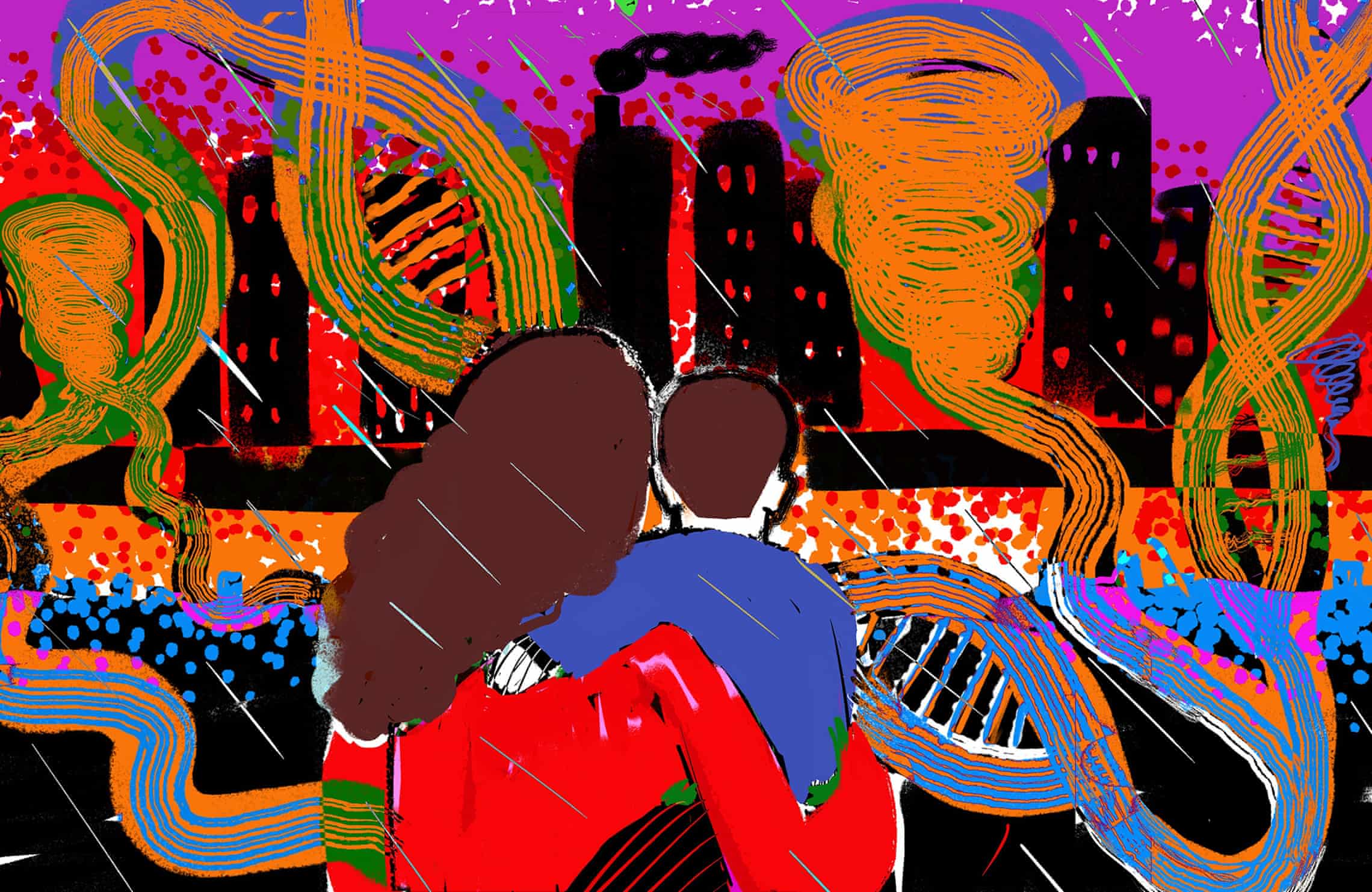
Are growing rates of anxiety, depression, ADHD, PTSD, Alzheimer’s and motor neurone disease related to rising temperatures and other extreme environmental changes?
Clayton Page Aldern
Wed 27 Mar 2024 05.00 GMTShare
In late October 2012, a category 3 hurricane howled into New York City with a force that would etch its name into the annals of history. Superstorm Sandy transformed the city, inflicting more than $60bn in damage, killing dozens, and forcing 6,500 patients to be evacuated from hospitals and nursing homes. Yet in the case of one cognitive neuroscientist, the storm presented, darkly, an opportunity.
Yoko Nomura had found herself at the centre of a natural experiment. Prior to the hurricane’s unexpected visit, Nomura – who teaches in the psychology department at Queens College, CUNY, as well as in the psychiatry department of the Icahn School of Medicine at Mount Sinai – had meticulously assembled a research cohort of hundreds of expectant New York mothers. Her investigation, the Stress in Pregnancy study, had aimed since 2009 to explore the potential imprint of prenatal stress on the unborn. Drawing on the evolving field of epigenetics, Nomura had sought to understand the ways in which environmental stressors could spur changes in gene expression, the likes of which were already known to influence the risk of specific childhood neurobehavioural outcomes such as autism, schizophrenia and attention deficit hyperactivity disorder (ADHD).
The storm, however, lent her research a new, urgent question. A subset of Nomura’s cohort of expectant women had been pregnant during Sandy. She wanted to know if the prenatal stress of living through a hurricane – of experiencing something so uniquely catastrophic – acted differentially on the children these mothers were carrying, relative to those children who were born before or conceived after the storm.
More than a decade later, she has her answer. The conclusions reveal a startling disparity: children who were in utero during Sandy bear an inordinately high risk of psychiatric conditions today. For example, girls who were exposed to Sandy prenatally experienced a 20-fold increase in anxiety and a 30-fold increase in depression later in life compared with girls who were not exposed. Boys had 60-fold and 20-fold increased risks of ADHD and conduct disorder, respectively. Children expressed symptoms of the conditions as early as preschool.

“Our findings are extremely alarming,” the researchers wrote in a 2022 study summarising their initial results. It is not the type of sentence one usually finds in the otherwise measured discussion sections of academic papers.
Yet Nomura and her colleagues’ research also offers a representative page in a new story of the climate crisis: a story that says a changing climate doesn’t just shape the environment in which we live. Rather, the climate crisis spurs visceral and tangible transformations in our very brains. As the world undergoes dramatic environmental shifts, so too does our neurological landscape. Fossil-fuel-induced changes – from rising temperatures to extreme weather to heightened levels of atmospheric carbon dioxide – are altering our brain health, influencing everything from memory and executive function to language, the formation of identity, and even the structure of the brain. The weight of nature is heavy, and it presses inward.
Evidence comes from a variety of fields. Psychologists and behavioural economists have illustrated the ways in which temperature spikes drive surges in everything from domestic violence to online hate speech. Cognitive neuroscientists have charted the routes by which extreme heat and surging CO2 levels impair decision-making, diminish problem-solving abilities, and short-circuit our capacity to learn. Vectors of brain disease, such as ticks and mosquitoes, are seeing their habitable ranges expand as the world warms. And as researchers like Nomura have shown, you don’t need to go to war to suffer from post-traumatic stress disorder: the violence of a hurricane or wildfire is enough. It appears that, due to epigenetic inheritance, you don’t even need to have been born yet.
When it comes to the health effects of the climate crisis, says Burcin Ikiz, a neuroscientist at the mental-health philanthropy organisation the Baszucki Group, “we know what happens in the cardiovascular system; we know what happens in the respiratory system; we know what happens in the immune system. But there’s almost nothing on neurology and brain health.” Ikiz, like Nomura, is one of a growing cadre of neuroscientists seeking to connect the dots between environmental and neurological wellness.
As a cohesive effort, the field – which we might call climatological neuroepidemiology – is in its infancy. But many of the effects catalogued by such researchers feel intuitive.

Perhaps you’ve noticed that when the weather gets a bit muggier, your thinking does the same. That’s no coincidence; it’s a nearly universal phenomenon. During a summer 2016 heatwave in Boston, Harvard epidemiologists showed that college students living in dorms without air conditioning performed standard cognitive tests more slowly than those living with it. In January of this year, Chinese economists noted that students who took mathematics tests on days above 32C looked as if they had lost the equivalent of a quarter of a year of education, relative to test days in the range 22–24C. Researchers estimate that the disparate effects of hot school days – disproportionately felt in poorer school districts without access to air conditioning and home to higher concentrations of non-white students – account for something on the order of 5% of the racial achievement gap in the US.
Cognitive performance is the tip of the melting iceberg. You may have also noticed, for example, your own feelings of aggression on hotter days. You and everyone else – and animals, too. Black widow spiders tend more quickly toward sibling cannibalism in the heat. Rhesus monkeys start more fights with one another. Baseball pitchers are more likely to intentionally hit batters with their pitches as temperatures rise. US Postal Service workers experience roughly 5% more incidents of harassment and discrimination on days above 32C, relative to temperate days.
Neuroscientists point to a variety of routes through which extreme heat can act on behaviour. In 2015, for example, Korean researchers found that heat stress triggers inflammation in the hippocampus of mice, a brain region essential for memory storage. Extreme heat also diminishes neuronal communication in zebrafish, a model organism regularly studied by scientists interested in brain function. In human beings, functional connections between brain areas appear more randomised at higher temperatures. In other words, heat limits the degree to which brain activity appears coordinated. On the aggression front, Finnish researchers noted in 2017 that high temperatures appear to suppress serotonin function, more so among people who had committed violent crimes. For these people, blood levels of a serotonin transporter protein, highly correlated with outside temperatures, could account for nearly 40% of the fluctuations in the country’s rate of violent crime.

“We’re not thinking about any of this,” says Ikiz. “We’re not getting our healthcare systems ready. We’re not doing anything in terms of prevention or protections.”
Ikiz is particularly concerned with the neurodegenerative effects of the climate crisis. In part, that’s because prolonged exposure to heat in its own right – including an increase of a single degree centigrade – can activate a multitude of biochemical pathways associated with neurodegenerative diseases such as Alzheimer’s and Parkinson’s. Air pollution does the same thing. (In rats, such effects are seen after exposure to extreme heat for a mere 15 minutes a day for one week.) Thus, with continued burning of fossil fuels, whether through direct or indirect effects, comes more dementia. Researchers have already illustrated the manners in which dementia-related hospitalisations rise with temperature. Warmer weather worsens the symptoms of neurodegeneration as well.
Prior to her move to philanthropy, Ikiz’s neuroscience research largely focused on the mechanisms underlying the neurodegenerative disease amyotrophic lateral sclerosis (ALS, also known as Lou Gehrig’s disease or motor neurone disease). Today, she points to research suggesting that blue-green algae, blooming with ever-increasing frequency under a changing global climate, releases a potent neurotoxin that offers one of the most compelling causal explanations for the incidence of non-genetic ALS. Epidemiologists have, for example, identified clusters of ALS cases downwind of freshwater lakes prone to blue-green algae blooms.

It’s this flavour of research that worries her the most. Children constitute one of the populations most vulnerable to these risk factors, since such exposures appear to compound cumulatively over one’s life, and neurodegenerative diseases tend to manifest in the later years. “It doesn’t happen acutely,” says Ikiz. “Years pass, and then people get these diseases. That’s actually what really scares me about this whole thing. We are seeing air pollution exposure from wildfires. We’re seeing extreme heat. We’re seeing neurotoxin exposure. We’re in an experiment ourselves, with the brain chronically exposed to multiple toxins.”
Other scientists who have taken note of these chronic exposures resort to similarly dramatic language as that of Nomura and Ikiz. “Hallmarks of Alzheimer disease are evolving relentlessly in metropolitan Mexico City infants, children and young adults,” is part of the title of a recent paper spearheaded by Dr Lilian Calderón-Garcidueñas, a toxicologist who directs the University of Montana’s environmental neuroprevention laboratory. The researchers investigated the contributions of urban air pollution and ozone to biomarkers of neurodegeneration and found physical hallmarks of Alzheimer’s in 202 of the 203 brains they examined, from residents aged 11 months to 40 years old. “Alzheimer’s disease starting in the brainstem of young children and affecting 99.5% of young urbanites is a serious health crisis,” Calderón-Garcidueñas and her colleagues wrote. Indeed.
Such neurodevelopmental challenges – the effects of environmental degradation on the developing and infant brain – are particularly large, given the climate prognosis. Rat pups exposed in utero to 40C heat miss brain developmental milestones. Heat exposure during neurodevelopment in zebrafish magnifies the toxic effects of lead exposure. In people, early pregnancy exposure to extreme heat is associated with a higher risk of children developing neuropsychiatric conditions such as schizophrenia and anorexia. It is also probable that the ALS-causing neurotoxin can travel in the air.
Of course, these exposures only matter if you make it to an age in which neural rot has a chance to manifest. Neurodegenerative disease mostly makes itself known in middle-aged and elderly people. But, on the other hand, the brain-eating amoeba likely to spread as a result of the climate crisis – which is 97% fatal and will kill someone in a week – mostly infects children who swim in lakes. As children do.
A coordinated effort to fully understand and appreciate the neurological costs of the climate crisis does not yet exist. Ikiz is seeking to rectify this. In spring 2024, she will convene the first meeting of a team of neurologists, neuroscientists and planetary scientists, under the banner of the International Neuro Climate Working Group.
The goal of the working group (which, full disclosure, I have been invited to join) is to wrap a collective head around the problem and seek to recommend treatment practices and policy recommendations accordingly, before society finds itself in the midst of overlapping epidemics. The number of people living with Alzheimer’s is expected to triple by 2050, says Ikiz – and that’s without taking the climate crisis into account. “That scares me,” she says. “Because in 2050, we’ll be like: ‘Ah, this is awful. Let’s try to do something.’ But it will be too late for a lot of people.
“I think that’s why it’s really important right now, as evidence is building, as we’re understanding more, to be speaking and raising awareness on these issues,” she says. “Because we don’t want to come to that point of irreversible damage.”
For neuroscientists considering the climate problem, avoiding that point of no return implies investing in resilience research today. But this is not a story of climate anxiety and mental fortitude. “I’m not talking about psychological resilience,” says Nomura. “I’m talking about biological resilience.”
A research agenda for climatological neuroepidemiology would probably bridge multiple fields and scales of analysis. It would merge insights from neurology, neurochemistry, environmental science, cognitive neuroscience and behavioural economics – from molecular dynamics to the individual brain to whole ecosystems. Nomura, for example, wants to understand how external environmental pressures influence brain health and cognitive development; who is most vulnerable to these pressures and when; and which preventive strategies might bolster neurological resilience against climate-induced stressors. Others want to price these stressors, so policymakers can readily integrate them into climate-action cost-benefit analyses.
For Nomura, it all comes back to stress. Under the right conditions, prenatal exposure to stress can be protective, she says. “It’s like an inoculation, right? You’re artificially exposed to something in utero and you become better at handling it – as long as it is not overwhelmingly toxic.” Stress in pregnancy, in moderation, can perhaps help immunise the foetus against the most deleterious effects of stress later in life. “But everybody has a breaking point,” she says.
Identifying these breaking points is a core challenge of Nomura’s work. And it’s a particularly thorny challenge, in that as a matter of both research ethics and atmospheric physics, she and her colleagues can’t just gin up a hurricane and selectively expose expecting mothers to it. “Human research in this field is limited in a way. We cannot run the gold standard of randomised clinical trials,” she says. “We cannot do it. So we have to take advantage of this horrible natural disaster.”
Recently, Nomura and her colleagues have begun to turn their attention to the developmental effects of heat. They will apply similar methods to those they applied to understanding the effects of Hurricane Sandy – establishing natural cohorts and charting the developmental trajectories in which they’re interested.
The work necessarily proceeds slowly, in part because human research is further complicated by the fact that it takes people longer than animals to develop. Rats zoom through infancy and are sexually mature by about six weeks, whereas for humans it takes more than a decade. “That’s a reason this longitudinal study is really important – and a reason why we cannot just get started on the question right now,” says Nomura. “You cannot buy 10 years’ time. You cannot buy 12 years’ time.” You must wait. And so she waits, and she measures, as the waves continue to crash.
Clayton Page Aldern’s book The Weight of Nature, on the effects of climate change on brain health, is published by Allen Lane on 4 April.










 Prescriptions for 64.7m items of antidepressants were dispensed in England in 2016, the highest level recorded by the NHS.
Prescriptions for 64.7m items of antidepressants were dispensed in England in 2016, the highest level recorded by the NHS.  Research has shown that supplements like zinc, magnesium and vitamins B and D can improve the mental capacity of people with Alzheimer’s.
Research has shown that supplements like zinc, magnesium and vitamins B and D can improve the mental capacity of people with Alzheimer’s. 














